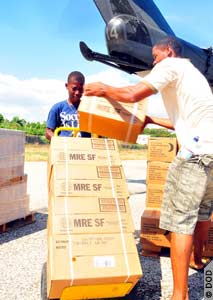 U.N. Secretary-General Ban Ki-moon and former U.S. President Bill Clinton, the U.N. special envoy for Haiti, said Haitian citizens are now being employed in the relief and reconstruction effort, not only adding more personnel to the effort, but also giving them a means to earn money to boost the local economy as it attempts to recover from the January 12 earthquake.
U.N. Secretary-General Ban Ki-moon and former U.S. President Bill Clinton, the U.N. special envoy for Haiti, said Haitian citizens are now being employed in the relief and reconstruction effort, not only adding more personnel to the effort, but also giving them a means to earn money to boost the local economy as it attempts to recover from the January 12 earthquake.
(Photo, right, Haitians work to unload U.S.-provided Meals-Ready-to-Eat from a Navy CH-53E Sea Dragon that has been flying from the aircraft carrier USS Carl Vinson, floating off the Haitian coast as part of “Operation Unified Response.”)
Speaking at the United Nations headquarters in New York January 21, Ban said that through the U.N.’s Cash-for-Work program, “we can employ many young men and women who can really devote themselves to the early phase of recovery: cleaning the streets and cleaning demolished places, and also other economic activities.”
Creating jobs for Haitians will contribute to the revitalization of the Haitian economy, he said.
According to a January 21 article by the U.N. News Centre, the United Nations Development Program (UNDP) has already employed almost 400 Haitians to deliver humanitarian aid, and the Cash-for-Work program is being expanded to include an additional 700 jobs for Haitians to remove rubble and restore essential infrastructure components, such as electricity.
Clinton said January 21 that it is “really important to give young people something positive to do, and a lot of people there want to be a part of rebuilding their country.”
Tim Callaghan, the U.S. Agency for International Development’s senior regional adviser who is coordinating USAID’s efforts in Haiti, said in a January 22 teleconference that the Cash-for-Work program will be “one part of many activities” to get Haiti’s economy going again, and will be “closely aligned with the priorities of the Haitian government.”
Callaghan mentioned the recent work of a Haitian search-and-rescue team that is participating in the program. “It was great, them involved in what turned out to be a live rescue,” he said. So far, 122 people have been retrieved alive from collapsed buildings.
More broadly, Clinton said, even though the earthquake response is still in the emergency phase, Haitian leaders are already thinking about the future recovery of the country.
“They are really trying to think differently. They understand that for all of the burdens of this, they have a bigger responsibility than ever before to give the Haitian people a different and better future,” he said.
The Haitian people are “going to be given the opportunity to, in effect, re-imagine their country,” Clinton said, and the earthquake recovery will be integrated into the country’s larger development strategy. “This is an opportunity here,” he said.
Comparing Haiti’s recovery to how U.S. officials have approached New Orleans following the 2005 devastation wrought by Hurricane Katrina, Clinton said Haiti’s government will want new buildings to be more hurricane- and earthquake-resistant. “They may also be able to do what’s being done in [New Orleans’] Lower Ninth Ward, and at lower costs build more energy-efficient buildings, using all kinds of different materials that are handy to them, that will encourage better sanitation, less deforestation, a lot of other things.”
According to the latest figures provided by USAID, 96,000 people are receiving daily food and water supplies through four established distribution points. As of January 20, U.S. military forces had distributed more than 400,000 meals and more than 600,000 bottles of water. In addition to potable water being available at 45 distribution points, water tanks are being installed in each zone of Port-au-Prince. USAID has delivered nine water-treatment units to provide 900,000 liters of safe drinking water to accommodate 90,000 people per day, and the USS Carl Vinson is producing nearly 400,000 liters of potable water every day.
The January 21 USAID fact sheet added that additional water, food, medical supplies, blankets, sheltering equipment and other materials have arrived in the country or are on the way. So far, the U.S. government has provided nearly $171 million in humanitarian assistance for Haiti.
U.S. military aircraft, helicopters and vessels are currently giving the highest priority to the shipment of water for the relief effort.
“Our effort is ongoing and we are … working as hard as we can to address the many needs of the Haitians,” USAID’s Callaghan said January 22. (America.gov)



















